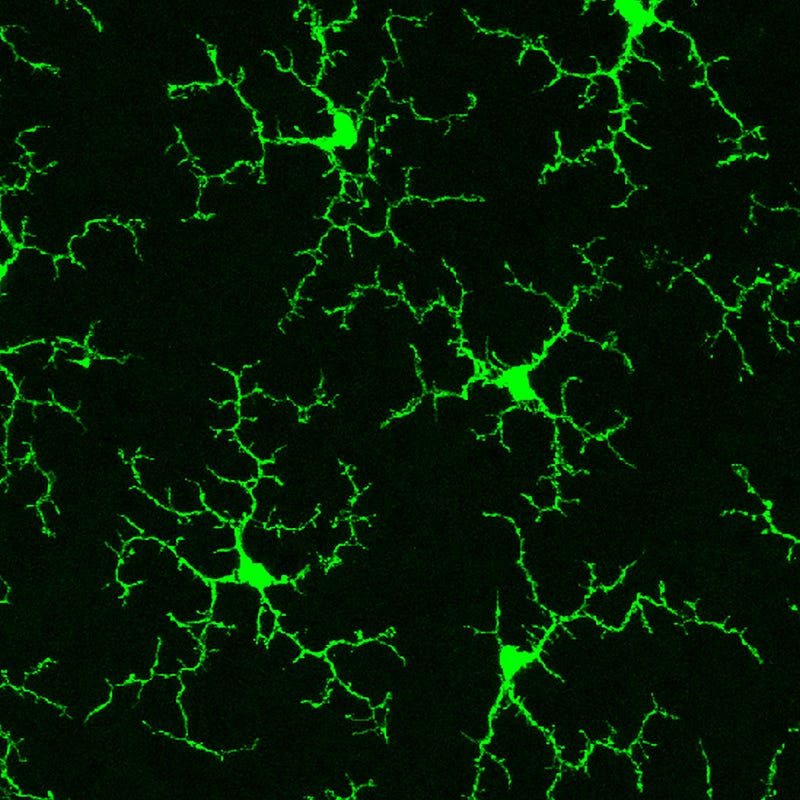Exploring Microglial Replacement as a Strategy Against Neurodegeneration
Written on
Chapter 1: Understanding Microglia and Their Role
In the realm of neuroscience, one particular type of cell has often taken center stage: the neuron. These elongated cells, with their intricate dendrites and axons, are responsible for transmitting information across the brain. However, as we delve deeper into the complexities of brain function, it becomes increasingly evident that supporting cells also play crucial roles. Among these, microglia stand out as key players.
Microglia, a category of immune cells known as macrophages, do not generate electrical signals like neurons, but they are vital for maintaining brain health. Acting as scavengers, these cells patrol the brain to remove plaques, damaged neurons, and pathogens.
Emerging research indicates that microglia may significantly impact neurodegenerative diseases, such as Alzheimer's Disease (AD). Damaged microglia exhibit heightened activity of enzymes associated with cellular aging and increase the expression of genes linked to a senescence-associated secretory phenotype. This state triggers the release of inflammatory substances and accelerates the aging process in neighboring cells.
Section 1.1: The Dilemma of Microglial Replacement
However, tampering with microglia is fraught with challenges—unless one can replace them with upgraded versions.
While microglia are part of the immune system and could theoretically be derived from bone marrow, the reality is more complex. Most microglia originate during embryonic development and remain in the brain for life. They are long-lived and self-sustaining. In older age, the loss of microglia may be partially compensated for by cells from the bone marrow, but this process becomes less effective as the bone marrow's capacity diminishes.
Although bone marrow transplants present an intriguing possibility, resident microglia are notoriously resistant to displacement. Scientific literature describes the obstacles in replacing microglia with myeloid cells derived from bone marrow as a result of inconsistent incorporation into the central nervous system.
So, what if we first eliminate the existing microglia?
This question was the focus of recent research conducted on mice. The researchers successfully achieved a rapid and nearly complete replacement of microglia using circulation-derived myeloid cells (CDMCs), overcoming the variability typically seen with conventional bone marrow transplantation.
Subsection 1.1.1: The Experimental Approach

To implement this, the mice received a bone marrow transplant alongside a four-week treatment with PLX5622, a compound that selectively targets microglia. Remarkably, this resulted in the replacement of up to 90% of the old microglia with CDMCs. These myeloid cells migrated to the brain through the bloodstream and adapted to take on microglia-like characteristics. Notably, these newly formed cells were more efficient at clearing cellular debris.
To assess the therapeutic potential of this microglial replacement, the researchers utilized mice with a Prosaposin deficiency, a condition marked by progressive neurodegeneration. The results were promising; the microglial replacement not only slowed neurodegeneration but also improved motor function and increased survival rates in these mice.
Section 1.2: Implications for Future Research
The authors of the study concluded that their proof-of-concept findings suggest that effective microglial replacement could offer therapeutic benefits for various neurological disorders. While these results are compelling, it is essential to note that they were obtained in mice with a specific condition.
Nevertheless, given the crucial role of microglia in maintaining brain health and their involvement in numerous neurological diseases, this line of research warrants further exploration.
Chapter 2: Expanding the Horizons of Microglial Research
This video titled "Unraveling the Role of Microglia in Neurodegenerative Diseases" delves into the intricate functions of microglia in various brain disorders, highlighting their potential roles in both health and disease.
The second video, "Redefining Microglia States and Function in Alzheimer's Disease," explores how alterations in microglial function can influence the progression of Alzheimer's, offering insights into future therapeutic strategies.
In conclusion, the findings of this study underscore the importance of microglial health and the potential for innovative treatments aimed at neurodegenerative diseases. Thank you for engaging with this content. If you’re interested in broader discussions around science and philosophy, consider subscribing to my newsletter, Thinking Ahead.